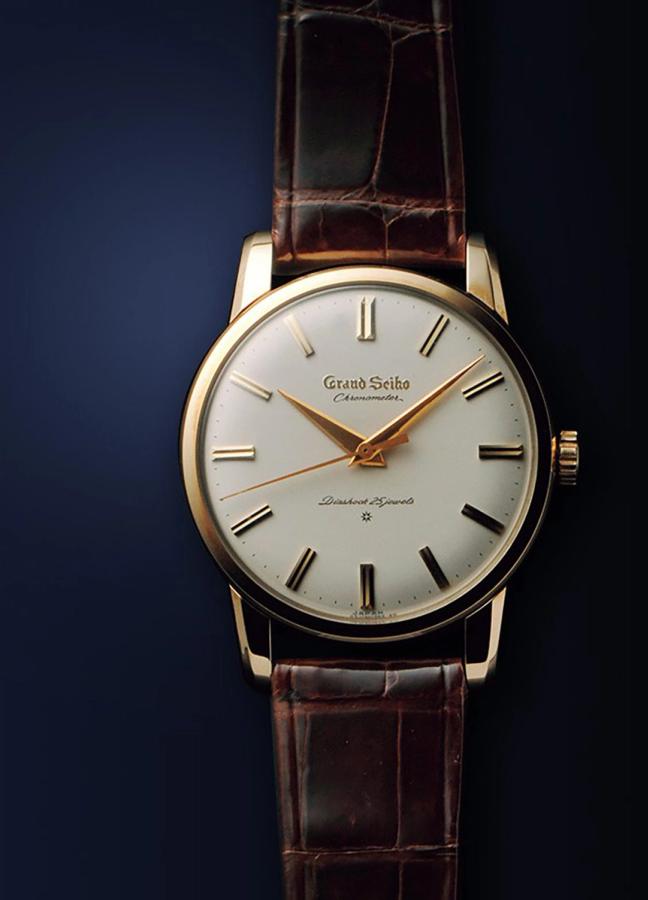

Grand Seiko — practically infused with natural influences — is a brand for all seasons. And that’s a good thing. Because, in Japan, they have more than most. Throughout the year, twenty-four separate ‘Sekki’ (seasons of shorter durations) mark significant changes in weather, from spring’s beginnings to the summer solstice. And these annual observances are perhaps at their most punctual — and poetic — come the winter months; the very season we now find ourselves starting.
From Sōkō to Shōkan, Taisetsu to Tōji, the distinctly wintry days ahead will mark everything from the first descent of frost to the heaviest snowfalls. And, on hand and wrist along the way, we will entrust Grand Seiko to keep every month, minute and second of the season — just as it has for over six long decades.
Because the first ever Grand Seiko model was produced 62 years ago, in the storied Suwa Seikosha studio of Japan’s Nagano prefecture. This initial timepiece was based on the Seiko Watch Corporation’s existing, equally regal ‘Crown’ model. And it was a handsome thing; with a 25-jewel, manual-winding calibre and limited run.
It also made history for its technical prowess, becoming the first-ever chronometer-grade watch manufactured in Japan, in compliance with the standard of the Bureaux Officiels de Controle de la Marche des Montres in Geneva – the precursor to the COSC (Official Swiss Chronometer Testing Institute). This wristwatch was extraordinarily accurate for the time, and offered a power reserve of 45 hours. It had a compact round case, applied hour markets and a raised logo on its white, slightly flecked snowstorm of a dial. This unassuming nod to winter weather was to be oddly prescient; a portent for the nature-inspired models to come.

The first ever Grand Seiko wristwatch
And many more models did come. In 1967, the ‘62GS’ became the first self-winding model from Grand Seiko. 1970’s ‘56GS’ saw a step towards the slimmer, more refined timepieces the brand had challenged itself to create. And, by 1988, the first quartz Grand Seiko added its own energy to the line-up. The intervening years saw yet more innovations: anti-magnetic watches; fourth hands, showing GMT; new alloys and ceramics.
In 2004, the unique ‘Spring Drive’ calibre arrived — debuting with the watchmaker’s ‘9R6’ series. It’s a magnificent movement; the pioneering product of 28 years of research, development and ambition. It combined a traditional mainspring with an electronic regulator, marrying the best of both quartz and mechanical watches to create a highly accurate timepiece powered by the wearer’s motion, its precision regulated by a crystal oscillator.
It had an extended power reserve, to ensure it remained precise after even a weekend off the wrist, and proved just how extensively Grand Seiko had managed to integrate the twin arts of technology and craftsmanship. Few calibres, to this day, boast such versatility and practicality. And, although it may be ‘spring’ by name, this is a movement — much like every one of Grand Seiko’s many models — for all seasons.
And this season, as the days draw in and the flurries of ‘Shōsetsu’ approach, is the perfect time to acquaint yourself with the Japanese watchmaker. The marque may seem far-flung, handcrafting watches surrounded by a crown of mountains in Honshū’s Matsumoto Basin, but, this year, Grand Seiko has opened a new boutique, bringing a touch of ‘Taisetsu’ to London’s New Bond Street.

With its stately façade and grand entrance, 68 New Bond Street is the brand’s first two-storey boutique in the world, and expansive windows (lining the covered passage to Medici Court and Hanover Square, en route to the new Bond Street Elizabeth Line station) offer everyone a glimpse at its watchmaking wares. The boutique is a haven of horology; a bastion of the best watches from one of the world’s finest watchmakers. It also allows fans of the brand to explore both the Grand Seiko and Seiko collections, with dedication showrooms for each. And, for the most ardent aficionados, a private lounge on the first floor houses a display of the marque’s fabled ‘Credor’ timepieces. You’ll even have the opportunity to see historic watches, on loan from Tokyo’s Seiko Museum.
This winter, there are a handful of must-see watches — each one more frosted and glacially, meticulously handmade than the last. There’s a trio of timepieces inspired by the white birch forests near Grand Seiko’s studio in Shizukuishi, all with deep, textured dials and bridges that resemble the gently curving outline of nearby Mount Iwate. But our three favourite models of the season all evoke that most wintry of weather; snow.
First up, there’s the Heritage Collection’s ‘SBGA211’, the ‘Snowflake’. Inspired by the Hotaka mountains, this watch captures the spirit of the snow-driven slopes upon its subtly textured dial. It’s a gentle, delicate design, tempered by an icy blue steel Seconds hand that glides around the face — the uniquely smooth signature of the inimitable ‘Spring Drive’.
The ‘Snowflake’
The ‘White Birch’
The ‘Skyflake’
There’s also the ‘Skyflake’; the ‘SBGA407’ from Grand Seiko’s Elegance Collection. This one’s specifically inspired by the refined reflection of the blues skies and the alpine nature that surrounds the Shinshu studio.
But perhaps our favourite of these wintry watches is this; the ‘SBGY007’ Omiwatari. Another entry in the Elegance Collection, this one ticks to life a local legend. During cold spells, the waters of Lake Suwa, in the Nagano Prefecture, freeze solid — and a long ridge appears, bisecting the body of water. Tradition tells of this ridge, explaining it and naming it ‘Omiwatari’; a path where the Gods stride out across the ice.
Grand Seiko’s take on the tale immortalises this legend. It recreates the mythical icy texture atop its stainless steel case, but also benefits from the Spring Drive calibre ‘9R31’, a dual spring barrel movement that delivers a power reserve of 72 hours when wound. And this achievement, of the Omiwatari simultaneously celebrating both the landscape and the lore of where these wonderful watches are made, is emblematic of an even greater Grand Seiko feat.
The watchmaker stands apart from the COSC-certified chronometers of Europe. Its mechanical watches are examined to a more stringent standard at their own facilities for a period of 17 days, in six different positions and at three different temperatures. Grand Seiko is proud of its own ‘Japaneseness’ in culture and craftsmanship, and this dignity is writ large across every wintery dial.
Want more from the Seiko Watchmaking Corporation? Here’s how King Seiko reclaimed the watchmaking throne…
Become a Gentleman’s Journal member. Find out more here.



